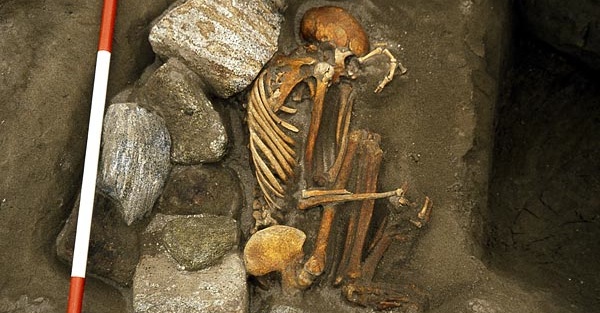Frankenstein’s Mummy Found In Scotland
Curiouser and curiouser!

Scientists have discovered that two 3,000 year old Scottish “bog bodies” — a male and a female — unearthed a decade ago are actually composed of the remains of six people — yep, that’s right, they just might have found the real Frankenstein’s monsters.
The skeletons were found below the remnants of 11th-century houses at Cladh Hallan, on an island right off the coast of Scotland. They were buried in the fetal position roughly 300 to 600 years after their death, leading scientists to believe they were briefly placed in a peat bog just long enough to preserve them and then re-buried.
According to Terry Brown, a professor of biomedical archaeology at the University of Manchester, there were a few things that just didn’t seem quite right when they dug up the bodies: “the jaw didn’t fit into the rest of the skull,” he said, in addition to their bones being remarkably well-preserved, likely a product of the high-acid, low-oxygen environment of a peat bog, properties that inhibit the growth of bacteria that breaks down organic materials.
After a series of DNA tests, it was found that the female’s jawbone, skull, arm, and leg all came from different people, none of whom shared the same mother. While the female’s bones all came from around the same time period, “isotopic dating showed that the male mummy is made from people who died a few hundred years apart.”
The researches aren’t entirely certain why these ancient Scottish people decided to mix and match the bones of their ancestors — some cite practical reasons (“Maybe the head dropped off and they got another head to stick on”) while others choose to take a more meaningful view of the multi-boned bodies: “It seems the person is not so important, but the image is. So it’s not a single identity, but it’s representing something,” Brown said. In other words, perhaps this collection of bones comes to embody multiple lineages in one symbolic uber-ancestor. Or, hey, maybe Mary Shelley totally got Frankenstein right, just thousands of years late.
If there are more bone puzzle bodies to be found, they will certainly be extremely old: “I think you’d have to go back to a time when the rituals were more bizarre,” Brown said. I think the jury’s still out on whether or not this funereal ritual is “bizarre” or if its symbolism is just way over our heads — perhaps we’ll learn more about the custom if we unearth more skeletons, fractured bodies previously lost in the “mists of unrecorded time.”
(via National Geographic.)
Are you following The Mary Sue on Twitter, Facebook, Tumblr, Pinterest, & Google +?
Have a tip we should know? tips@themarysue.com